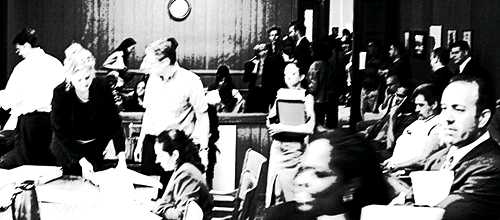Did the
Prosecutor get it right?

Suppose
a crime has
been committed and that the criminal has left some physical evidence,
such as some of their blood at the scene. Suppose the blood type is
such that only 1 in every 1000 people has the matching type. A suspect,
let's call him Fred,
who matches the blood type is put on trial. The prosecutor claims
that the probability that an innocent person has the matching blood
type is 1 in a 1000 (that's a probability of 0.001). Fred has
the matching blood type and therefore the probability that Fred is
innocent is just 1 in a 1000.
But the
prosecutor’s assertion, which sounds convincing and could
easily sway a jury, is wrong.
To see why, let's suppose that the crime could only have been committed
by an adult male and that in the population there are 10 million adult
males. Then from this population we would actually expect a
large
number of people who have the matching blood type (about 10,000). If
there is no evidence other than the blood to link Fred to the crime
then Fred
is no more likely than any of the other 9999 matching blood type men to
have committed the crime (but please see also the defendent's fallacy). This
means that the probability Fred is innocent
is actually 99.99% (i.e. 0.9999, which is rather different
from
the 0.001 claimed by the prosecution).
So what is the source of
the fallacy
and why do lawyers so commonly make it? It all boils down to a basic
misunderstanding about probability (a misunderstanding which many
intelligent people have because this kind of basic probability is never
taught at schools).
The misunderstanding is to assume that the probability of A given that
we know B is true, written P(A|B), is the same
as the probability of B given that we know A is true, written P(B|A).
(If you want an explanation of this without any maths at all, you should
read this page
first)
In this case let A be the assertion “Fred is
innocent”
and let B be the assertion “Fred has the matching blood
type”. What we really
want to know is P(A|B) (the probability Fred is innocent given that he
has
the matching blood type) and this is what the lawyer claims
is
equal to 1 in a 1000. But in fact, what we actually know is that P(B|A)
(the probability Fred has the matching blood type given he is innocent)
is
equal to 1
in a 1000.
The lawyer has simply stated the probability P(B|A) and claimed this is
actually the probability P(A|B).
The fallacy becomes
especially
challenging when DNA evidence is used. In such cases P(B|A) can be
extremely low, such as 1 in 10 million. When the lawyer wrongly asserts
that the probability of innocence is therefore 1 in 10 million it seems
especially convincing. But even in this case the probability of
innocence could actually be very high. Assuming again a population of
10 million people who could have committed the crime. Then it turns out
that the probability of more than one person having the matching DNA is
still actually quite high - about 0.46. So instead of the claimed 1 in
10 million probability of innocence the real probability is not much
less than 1 in 2. In such circumstances the ‘beyond
reasonable
doubt’ criteria can hardly be claimed to be met.
See the page on the fallacy of reasoning about
evidence in Court for further information about all of this.
For more information on fallacies in legal reasoning read this article:
Fenton NE and Neil M,
''The Jury
Observation Fallacy and the use of Bayesian Networks to present
Probabilistic Legal Arguments'', Mathematics Today ( Bulletin of the
IMA, 36(6)), 180-187, 2000.
which
is available here:
http://www.agenarisk.com/resources/white_papers/jury_fallacy_revised.pdf
